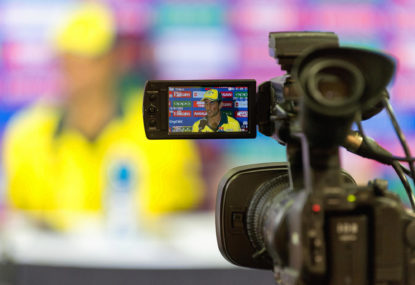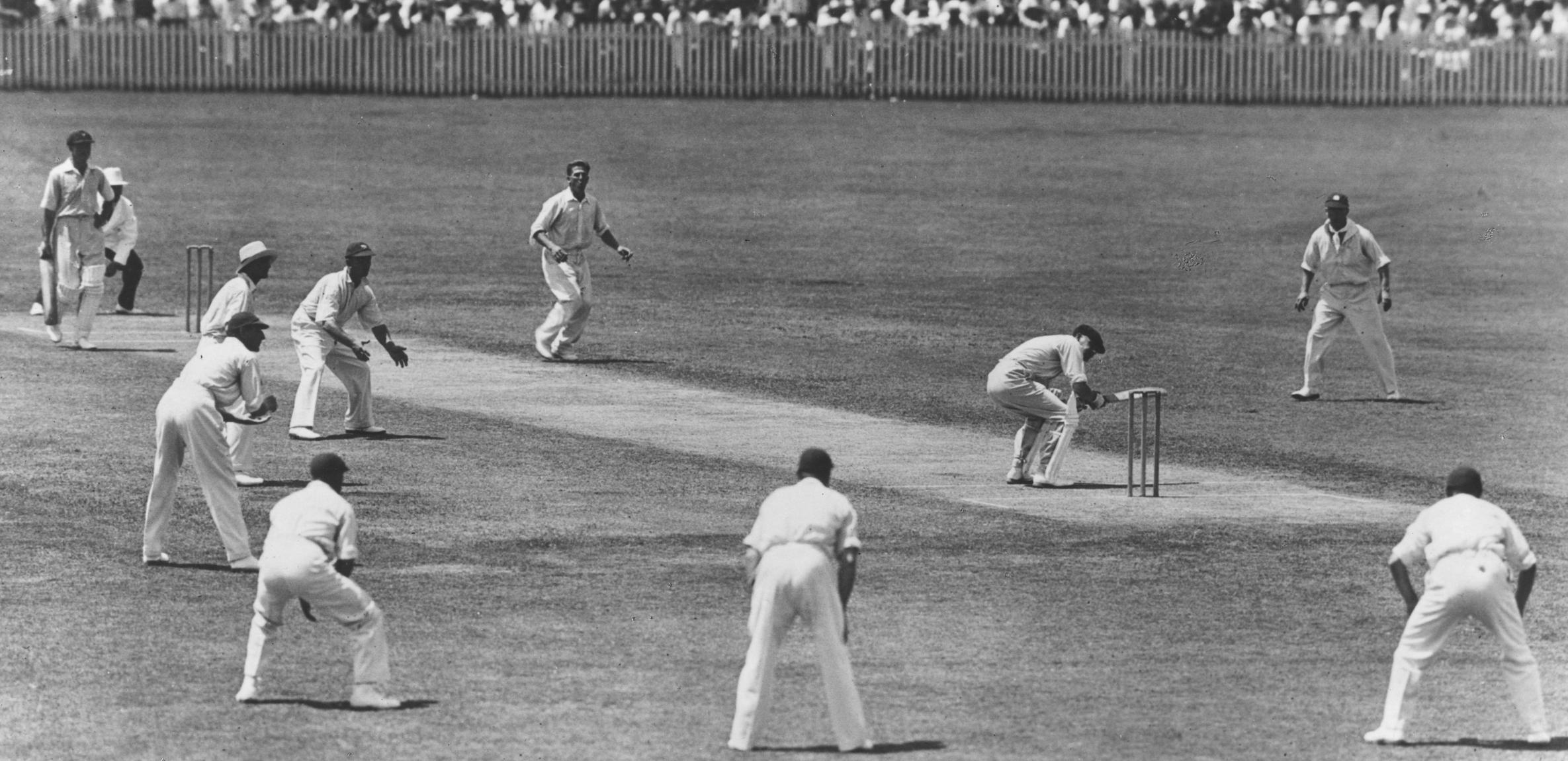WATCH: IPL ground staff member steals the show with an epic one-hander over the rope
Sign the man up for a contract next season!
Sponsored

Tapping a pencil against a coconut. That, quite literally, was what amounted to ‘special effects’ in the early days of Australian cricket broadcasting.
That rudimentary method for simulating the sound of bat on ball was used by the ABC during the 1934 Ashes in England. Move forward to 2018 and cricket fans are beguiled by an array of innovative technology deployed by broadcasters to enhance the viewing experience.
A horde of television cameras stationed at the ground provide viewers with endless replays and varied angles including those, on occasions, from directly above the ground – birdseye views provided by cameras strung on cables. The path of a delivery is predicted by ball-tracking technology and edges are confirmed by infrared imaging system HotSpot.
Not only do we get to watch the action from myriad angles but technology also shows us things our eyes can not pick up.
So how did we get here? How did cricket broadcasting in Australia evolve from something so primitive to something so sophisticated? To understand that, let’s go right back to where it all started.
The 1924 Ashes in Australia was a blockbuster Test series. World War I was a fading memory and Australia’s sporting culture was beginning to explode. Huge crowds flocked to each of the five Tests, one of which was played at Adelaide Oval, the other four split evenly between the MCG and the SCG.
Although Australia did not yet have Don Bradman, who was a 16-year-old dominating schoolboy cricket, they did boast legendary batsman Bill Ponsford and unstoppable leggie Clarrie Grimmett, while England had all-time great batsmen Jack Hobbs and Herbert Sutcliffe.

Australian leg spinner Clarrie Grimmett in action. (Photo by Central Press/Getty Images)
For the very first time that summer, those fans who could not attend the match were able to get something close to live commentary of the 1924 Ashes action. Radio had just arrived in Australia, with the first broadcast having occurred just a year earlier in late 1923. During the Ashes, Sydney radio station 2BL began offering live updates from the grounds at 15-minute intervals, with commentators giving summaries of what had occurred since their last update.
One year later, cricket broadcasting was truly born. In December 1925, Sydney radio station 2FC offered the first-ever ball-by-ball live coverage of a cricket match in Australia. Commentators LG Watts and HG Williams called the action of a match being used as a Test selection trial between Australia and The Rest at the SCG.
The following summer, cricket radio coverage expanded to include domestic matches, as well as international fixtures.
Cricket broadcasting in Australia really took off when the Australian Broadcasting Corporation was launched in 1932. The ABC, which boasted eight city and four regional radio stations, started just in time to provide live coverage of the most controversial series in Ashes history.
The summer of 1932-33 bore witness to the infamous Bodyline series. Bradman, by this stage the most popular athlete in Australia, was targeted by a relentless bouncer barrage and matching leg-side fields by England, a questionable tactic which was widely condemned.

Bill Woodfull ducks under a Harold Larwood bouncer during the Bodyline series. (Photo by Central Press/Getty Images)
When Australia toured England 18 months later, the ABC was unable to provide live ball-by-ball coverage from the grounds. Instead, they came up with the concept of a so-called ‘synthetic’ coverage of the matches. The ABC’s Sydney studios received cable messages from England which their commentators then read, describing each ball as if it was occurring live.
To enhance their coverage, the ABC overlaid sound effects, which included the aforementioned use of pencils on coconuts to give the impression of a ball being struck.
Cricket broadcasting coverage continued to grow in Australia and in the summer of 1938, when England toured for an Ashes series, the ABC was offering almost 30 hours per week of coverage. Commercial stations across the country also continued to provide extension coverage.
The following year saw the outbreak of World War II, which prompted a slight reduction in cricket on the radio for the next few years. After the war ended in 1945, however, cricket broadcasting surged in popularity. A quarter of all Australian households with radios tuned in to the home Ashes series in 1946-47.
In 1948, Bradman’s last Test series, the ABC made a major change to their approach for the Ashes series in England. Up until then, they could not cover overseas matches live from the grounds because radio waves were not capable of travelling such long distances. But in 1948, the quality of shortwave radio signals – a newer technology – was deemed good enough for the ABC to broadcast direct from the matches as they occurred in England.
This revolutionary cricket broadcast was a resounding success, with tens of thousands of Australians staying up each night to listen to Bradman’s men battling in England. The ABC’s Test match coverage was often its highest-rated program, as had been the case for many years up to this point. Despite the quality of their coverage, they were sometimes outrated by their many commercial radio competitors scattered across every city in Australia.
In return for being allowed to broadcast cricket matches, radio stations paid a fee to the State associations hosting the particular match. This modest fee was to pay for the use of the broadcast facilities at the ground – a far cry from the giant cricket broadcast rights fees media outlets have paid in the modern era.
That changed in 1950 when Australian Board of Control for International Cricket – the predecessor to the Australian Cricket Board – demanded much higher fees from radio stations, who they argued were earning substantial advertising revenue from their coverage. So began the first era of cricket broadcasting fee negotiations.
Then cricket broadcasting in Australia went through its greatest ever change in 1956 with the advent of television. The ABC very quickly began live television coverage of cricket, with the first match it broadcast being a Sheffield Shield fixture in November 1956. The first Test match broadcast on Australian TV was a women’s Ashes fixture played in Melbourne in February of 1958. Men’s Test cricket was to follow later that year.
This television coverage made the ABC the home of Australian cricket. Its national broadcasts only grew in popularity from the late 1950s through the 1960s and into the 1970s, as more and more Australia households owned televisions.
All that changed in 1977 when ABC TV’s effective monopoly on cricket ended thanks to the arrival of World Series Cricket. Channel Nine network boss Kerry Packer had spent years trying to get the TV rights for cricket but was continually rebuffed by the Australian Cricket Board. When in 1976 he offered a larger broadcast fee than the ABC, and was still rejected, he created a rival cricket product.
Packer signed up 66 top cricket players, including many of the world’s biggest stars, to play in tournaments for either Australia, the West Indies or the World XI. Among a host of innovations, the tournaments broadcast on Channel Nine featured day-night matches, coloured uniforms and white balls. A range of controversies emerged from this era in the late 1970s, but it ended with Nine finally beating the ABC to the rights to broadcast cricket in Australia.
Nine updated the TV coverage of cricket in the country, greatly increasing the number of cameras used at each ground, so the action could be viewed from varied angles. They also gradually introduced more and more elaborate graphics to enhance their coverage.
Like the ABC before them, Nine became the nation’s home of cricket, with their commentators like Richie Benaud, Bill Lawry and Tony Greig building on the fame they gained from their playing days. That quartet continued commentating all the way into the 2010s as Nine maintained their stranglehold on cricket in Australia.
Meanwhile, Channel 10 became a new player in the broadcasting of cricket by securing rights to cover the Big Bash League, a competition which earned them generous ratings.

The Big Bash has now moved to Foxtel. (AAP Image/Richard Wainwright)
Finally, this year, we have seen a changing of the guard. In a shock development, Foxtel and Seven West Media ended Nine’s four-decade grip on cricket by securing a six-year broadcast deal.
Foxtel secured all digital rights, together with simulcasts of free-to-air matches and exclusive rights to broadcast ODI and T20I matches, as well as 16 BBL fixtures. Seven, meanwhile, just have the rights to broadcast all of Australia’s home Tests as well as 43 matches of the Big Bash.
This broadcast deal effectively started last month with Foxtel providing live broadcasts of the JLT One-Day Cup. One nice benefit of this new arrangement is that fans can watch high-quality live streams of Fox’s coverage of these domestic matches, for free, via cricket.com.au.
The fuller test of the new cricket broadcasting arrangement will come next month when Australia’s home season begins with limited overs matches against South Africa and the start of their Test series against India.
While I can’t predict exactly what Foxtel and Seven’s coverage will look like, there’s one thing I can say with confidence: they won’t be tapping pencils against coconuts. Cricket broadcasting has come a long way.
With Foxtel showing every Australian home Test, ODI and T20I live and ad break-free during play, they’re the one-stop shop for all Aussie cricket fans. Get Foxtel today to make sure you don’t miss any of the great moments this summer with their dedicated 24/7 cricket channel.